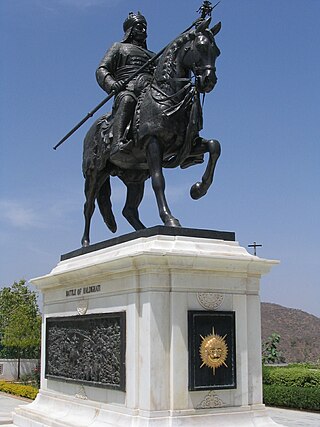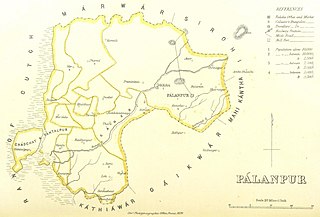Rajput, also called Thakur, is a large multi-component cluster of castes, kin bodies, and local groups, sharing social status and ideology of genealogical descent originating from the Indian subcontinent. The term Rajput covers various patrilineal clans historically associated with warriorhood: several clans claim Rajput status, although not all claims are universally accepted. According to modern scholars, almost all Rajput clans originated from peasant or pastoral communities.

Shekhawati is a semi-arid historical region located in the northeast part of Rajasthan, India. The region was ruled by Shekhawat Rajputs. Shekhawati is located in North Rajasthan, comprising the districts of Neem Ka Thana, Jhunjhunu, Sikar that lies to the west of the Aravalis and Churu. It is bounded on the northwest by the Bagar region, on the northeast by Haryana, on the east by Mewat, on the southeast by Dhundhar, on the south by Ajmer, and on the southwest by the Marwar region. Its area is 13,784 square kilometers.

Shekhawat is a clan of Rajputs found mainly in Shekhawati region of Rajasthan. Shekhawats are descendants of Maharao Shekha of Amarsar. Shekhawat is the most prominent sub-clan among Kachhwaha Rajputs. The Shekhawati region was ruled by them for more than 500 years and are honoured with the hereditary title of “Tazimi Sirdars”, whom HH the Maharaja of Jaipur receives by rising from his seat. Fought against mughals many time. Rao Sujjan Singh of Chhapoli fought mughal army with 300 men to save a temple. Col. J.C. Brooke in his book, Political History of India, wrote that “For the recruitment of Horse-army there is no region in India at par with Shekhawati.” Shekhawat is a very common surname in the Indian defence forces.

Loharu is a city, municipal committee and assembly constituency, near Bhiwani City in the Bhiwani district of the Indian state of Haryana. It is the administrative headquarters of one of the four administrative sub-divisions of the district and covers 119 villages. It is also a railway junction station.
Askot or Askote is a small Himalayan town in Pithoragarh district of Uttarakhand in India. It is the part of Kanalichhina development Block and Didihat Tehsil.
Muslim Rajputs or Musalman Rajpoots are the descendants of Rajputs in the northern regions of the Indian subcontinent who generally are followers of Islam. Reportedly, they converted from Hinduism to Islam from the medieval period onwards, creating various dynasties and states while retaining Hindu surnames such as Chauhan. Today, Muslim Rajputs can be found mostly in present-day Northern India and Pakistan. They are further divided into different clans.

Jadeja is a Rajput clan that inhabits the Indian state of Gujarat and the Tharparkar district of Sindh, Pakistan. They originated from Sammas of Sindh, a pastoral group, and laid a claim on the Rajput identity after marriages with Sodha Rajput women by adopting a process called Rajputisation.

Rana is a historical title denoting an absolute Hindu monarch in the Indian subcontinent. Today, it is used as a hereditary name in the Indian subcontinent. "Rana" was formerly used as a title of martial sovereignty by Rajput kings in India. Rani is the title for the wife of a rana or a female monarch. It also applies to the wife of a raja. Compound titles include rana sahib, ranaji, raj rana,rana bahadur, and maharana.

Naigarhi is a rural town in the Rewa district of Madhya Pradesh, India. It was founded by a Sengar Rajput king, Raja Chattradhari Singh. The town is notable for its medieval era architecture constructed by the Sengar kings.

Palanpur Agency, also spelled Pahlunpore Agency, was a political agency or collection of princely states in British India, within the Gujarat Division of Bombay Presidency. In 1933, the native states of the Mahi Kantha Agency, except for Danta, were included in the Western India States Agency. The agency, headquartered at Palanpur, oversaw some 17 princely states and estates in the area, encompassing an area of 6393 square miles (16,558 km2) and a population, in 1901, of 467,271.
Sengar, also known as Sanghar, Singraur or Songar, are a clan of Rajputs in India.
The Khanzada or Khan Zadeh are a cluster community of Muslim Rajputs found in the Indian states of Uttar Pradesh and Rajasthan. A notable community is the Khanzadas of Mewat, the descendants of Raja Nahar Khan, who are a sub-clan of Jadaun. They refer to themselves as Muslim Rajputs. After the Partition of India in 1947, many members of this community migrated to Pakistan.
The Kanet is a caste found in the state of Himachal Pradesh in North India. They are generally regarded as a Thakur (noble) caste, even though they have sometimes been classified otherwise.There is the subcaste of kanets which is known as "Mukhiya".
The Kandera, Kadera, Golandāz, Bāndar, Hawāidar is a Hindu community found mainly in the northern and central regions of India. They belong to the Kshatriya varna. In earlier times, they were archers and arrow-makers. Later, they also became involved in roles such as cannon operators, firework crafters, and the production of gunpowder and iron missiles. The term "Kandera" is derived from the Sanskrit word "Kandir", which means "an archer".
Mansoori (Mansuri) is the community of an Indian Muslim, and this community belongs to Pathans and Rajputs. They are regionally known as Mansoori, Naddaf and Pinjara. They are found in the states of Gujarat, Madhya Pradesh, Rajasthan, Uttar Pradesh, Bihar, and North India.
The Thakurai are a Muslim Rajput community found in the state of Bihar in India. They are mostly concentrated around East and West Champaran District and the surrounding region. A small number are also found in the Terai region of Nepal.
The Hurkiya are a caste found in the states of Uttar Pradesh and Uttarakhand in India. They have been granted Scheduled Caste status in both these states. In fact, there are two distinct communities that go by the name Hurkiya, those of Uttarakhand, who are Hindu by religion, and those found in western Uttar Pradesh, who are Muslim. Both Hurkiya are of common origin, being a sub-group within the Dom ethnic group, and are one of the many gypsy like grouping found in North India.
Maroth is a village located in Nawa, Nagaur district, in the state of Rajasthan, India. The area surrounding the village is named Gaurati, which means "The Land of Gaurs".
The Gandhavariya are a Rajput clan based in northern Bihar. They are descendants of King Vikramaditya of Malwa. In past they ruled over parts of Madhepura district and Saharsa district during medieval times after the decline of the Oiniwar Dynasty.
Gaur also known as "Gour" is a Hindu Rajput clan of India. They have ancient ancestry and find mention by James Tod as one of 36 royal races in his book Annals and Antiquities of Rajasthan The Gaur Rajputs once held a prominent position in Ajmer till the time of Prithviraj Chauhan. Gorwar region gets its name from this clan. In later years they lost the territories ruled by them. In 15th century, they fought at least 13 battles with Shekhawats were defeated and were reduced to feudetory or jagirdars in Shekhawati region. The Rajgarh territory was one of the last bastion of Gaur Rajputs during the times of Mughal Emperors, Humayun and Akber, which was lost to Kishan Singh in 17th century. Gaur Rajputs remained allies to Mughal till the time of Aurangzeb, whose political decisions, alienated Rathods, Sisodias, Hadas and Gaur Rajput from Mughals.






